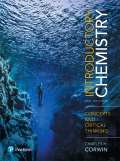
(a)
Interpretation:
The molecular collision equation of pure water is to be stated.
Concept introduction:
Pure water is not a very good conductor of electricity due to the presence of a very small number of ions that are responsible for the flow of electricity. This happens very rarely that two water molecules collide with the appropriate amount of energy to give back hydronium ion
(b)
Interpretation:
The molar hydrogen ion concentration at
Concept introduction:
Pure water is not a very good conductor of electricity due to the presence of a very small number of ions that are responsible for the flow of electricity. This happens very rarely that two water molecules collide with the appropriate amount of energy to give back hydronium ion
(c)
Interpretation:
The molar hydroxide ion concentration at
Concept introduction:
Pure water is not a very good conductor of electricity due to the presence of a very small number of ions that are responsible for the flow of electricity. This happens very rarely that two water molecules collide with the appropriate amount of energy to give back hydronium ion
Want to see the full answer?
Check out a sample textbook solution
Chapter 14 Solutions
EBK INTRODUCTORY CHEMISTRY
- Consider citric acid, H3C6H5O7, added to many soft drinks. The equilibrium constants for its step-wise ionization areKa1=7.5104 ,Ka2=1.7105, andKa3=4.0107. Write the overall net ionic equation and calculate K for the complete ionization of citric acid.arrow_forwardEqual molar quantities of hydrochloric acid and sodium hypochlorite (NaClO) are mixed. (a) Write the balanced, net ionic equation for the acid-base reaction that can, in principle, occur. (b) Does the equilibrium lie to the right or left?arrow_forwardFor each of the following reactions, indicate the Brønsted-Lowry acids and bases. What are the conjugate acid/base pairs? (a) H3 O+(aq)+CN(aq)HCN(aq)+H2O (b) HNO2(aq)+OH(aq)NO2(aq)+H2O (c) HCHO2(aq)+H2OCHO2(aq)+H3 O+(aq)arrow_forward
- 666please choose between the at the second questionarrow_forwardWhen someone blew into the flask that contained water with some universal indicator, and then shook the flask, the water color turned from yellow to reddish. Explain why.arrow_forwardWhy can a solid copper penny be dissolved in nitric acid, but not in hydrochloricacid? Modern pennies are made from zinc metal plated with copper. Whathappens to a modern penny when it is placed inside a bath of hydrochloric acidafter the penny is scratched, exposing some of the zinc?arrow_forward
 Chemistry: Principles and ReactionsChemistryISBN:9781305079373Author:William L. Masterton, Cecile N. HurleyPublisher:Cengage Learning
Chemistry: Principles and ReactionsChemistryISBN:9781305079373Author:William L. Masterton, Cecile N. HurleyPublisher:Cengage Learning Chemistry & Chemical ReactivityChemistryISBN:9781337399074Author:John C. Kotz, Paul M. Treichel, John Townsend, David TreichelPublisher:Cengage Learning
Chemistry & Chemical ReactivityChemistryISBN:9781337399074Author:John C. Kotz, Paul M. Treichel, John Townsend, David TreichelPublisher:Cengage Learning Chemistry & Chemical ReactivityChemistryISBN:9781133949640Author:John C. Kotz, Paul M. Treichel, John Townsend, David TreichelPublisher:Cengage Learning
Chemistry & Chemical ReactivityChemistryISBN:9781133949640Author:John C. Kotz, Paul M. Treichel, John Townsend, David TreichelPublisher:Cengage Learning



